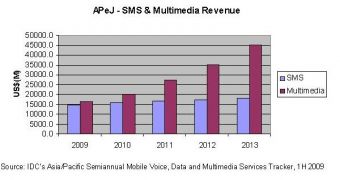Mobile multimedia services are expected to account for around 11 percent of the total mobile services revenue in Asia/Pacific excluding Japan (APEJ), by end of 2009, which will enable them to outpace the revenue from SMS services for the first time, according to a recently published report from IDC. During last year, SMS service accounted for 10.3 percent of the revenue in the non-voice area, while mobile multimedia services climbed to 10.1. According to IDC, SMS services will remain in the 10 percent area for the following few years, while mobile multimedia services will continue to grow.
Up until now, the growth in the mobile multimedia content has been mainly driven by ringtones and wallpaper downloads, mainly due to their popularity among young users. “Today, the emergence of handsets featuring larger screens and even touch-screen interfaces has pushed the uptake of mobile multimedia services to a new level,” said Alex Chau, senior research manager for IDC's Asia/Pacific Mobile & Wireless Technologies/Services Research. “This has spurred content and application developers to develop tens of thousands of applications to satisfy this new demand amongst mobile users.”
The growth in mobile multimedia services is also expected to be influenced by the fact that today's mobile phones come with advanced operating systems and connectivity options, offering users the possibility to quickly download content. Content sharing was unavailable to users up until recently, yet now they can take advantage of the handsets' USB, Bluetooth, or Wi-Fi connectivity options to access various content or allow others to access the files on their devices.
“The proliferation of EDGE, 3G UMTS and 3G HSPA enabled handsets has helped to spur the demand for mobile multimedia services over the years; however, the next stage of growth will require mobile operators to invest in and upgrade mobile networks in the region in order to handle the explosive mobile packet data traffic growth. In the markets where operators have already upgraded to HSPA 7.2, 14.4 Mbps and HSPA+ 21 Mbps, the take up of USB-dongle HSPA cards has been overwhelming, driving operators to ration the registration of new subscribers,” Alex added.
The price of these services is something that should attract an even larger number of users, due to the increased competition among carriers. The price is expected to become the main differentiator between carriers in developed markets and operators will also focus on delivering exclusive content to the market, especially since competitors like the Apple App Store already made their presence felt. According to IDC, the competition on the market will become more intense, something that will result in price wars from which users in APEJ will be those to benefit the most.

 14 DAY TRIAL //
14 DAY TRIAL //